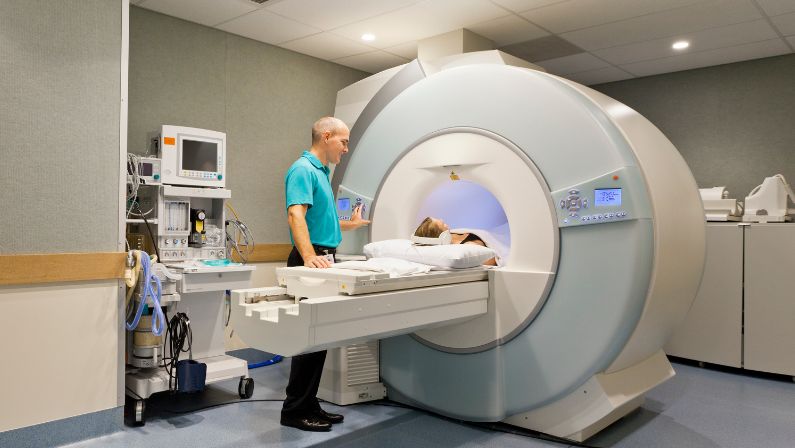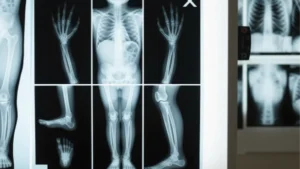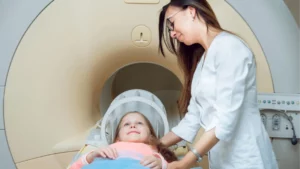In the battle against cancer, early detection is often the key to successful treatment and improved patient outcomes.
Medical advancements have paved the way for a range of diagnostic tools, one of which is the CT scan. Computed Tomography, commonly known as CT, is a powerful imaging technique that has revolutionized the field of medical diagnostics.
But can CT scans detect cancer?
In this article, we will explore the capabilities of CT scans in detecting various types of cancer, their role in the diagnostic process, and the benefits they offer in terms of early detection and treatment planning.
What is a CT Scan?
A CT scan is a medical imaging technique that combines X-ray technology with advanced computer processing to produce detailed cross-sectional images of the body.
It involves a series of X-ray images taken from different angles around the body, which are then reconstructed by a computer to create a three-dimensional view. This allows healthcare professionals to visualize internal structures, organs, and tissues with great clarity and precision.
Unlike traditional X-rays, which provide a single flat image, CT scans provide a more comprehensive and detailed picture, making them highly valuable in diagnosing a wide range of medical conditions, including cancer.
How CT scans are used in cancer detection
Can CT scan show cancer? Yes, CT scans play a crucial role in the detection and diagnosis of cancer. By capturing highly detailed images of the body, CT scans enable healthcare professionals to identify abnormal growths, tumors, or masses that may indicate the presence of cancer.
These scans can detect cancer in various parts of the body, including the lungs, liver, abdomen, pelvis, and bones.
Additionally, CT scans are useful in determining the stage of cancer, evaluating the size and location of tumors, and assessing if cancer has spread to nearby lymph nodes or other organs.
The ability of CT scans to provide precise anatomical information aids oncologists in developing personalized treatment plans and monitoring the progress of cancer therapies. With its non-invasive nature and high imaging resolution, CT scanning has become an invaluable tool in the early detection and management of cancer, leading to improved patient outcomes.

Types of cancers that can be detected using CT scans
CT scans are a valuable tool for detecting various types of cancers, allowing for early diagnosis and timely intervention. But how does a CT scan detect cancer? Here’s a list of cancer types and how the test helps in diagnosis.
- Lung cancer: Identifies lung nodules and evaluates the extent of lung cancer, aiding in treatment planning.
- Liver cancer: Detects liver tumors, evaluates their size and location, and determines if the cancer has spread to other areas.
- Pancreatic cancer: Provides detailed images of the pancreas, aiding in the detection and staging of pancreatic cancer.
- Colorectal cancer: Assesses the colon and rectum for tumors, helping diagnose and stage colorectal cancer.
- Kidney cancer: Identifies kidney tumors, evaluates their size and location, and determines if the cancer has spread to other structures.
- Ovarian cancer: Assists in the detection of ovarian masses or tumors, providing crucial information for diagnosis and treatment planning.
- Stomach cancer: Reveals the presence of stomach tumors and assesses their extent, aiding in the management of stomach cancer.
- Esophageal cancer: Evaluate the esophagus for tumors and determine the stage of esophageal cancer.
- Head and neck cancers: Provides detailed images of the head and neck region, aiding in the detection and evaluation of tumors in these areas.
- Bone cancer: Detects bone tumors and assesses their size and extent, assisting in the diagnosis and treatment of bone cancer.
- Brain and spinal cord tumors: Visualizes the brain and spinal cord, helping in the identification and characterization of tumors in these regions.
These are just a few examples of cancers that can be detected using CT scans, highlighting the versatility and importance of this imaging technique in cancer diagnosis and management.
The Role Of CT Scans In The Cancer Diagnostic Process
CT scans play a vital role in the comprehensive cancer diagnostic process, providing valuable information to healthcare professionals. They are utilized for:
Identifying suspicious masses
CT scans are highly effective in identifying suspicious masses or tumors within the body. By capturing detailed cross-sectional images, CT scans enable radiologists to visualize abnormal growths that may indicate the presence of cancer. This initial identification helps initiate further investigations and diagnostic procedures.
Guiding biopsies
CT scans are instrumental in guiding the precise placement of needles during biopsies. By accurately mapping the location and depth of a tumor, CT-guided biopsies allow for the collection of tissue samples for laboratory analysis, aiding in the definitive diagnosis of cancer and determining its specific characteristics.
Assessing the extent of cancer (staging)
CT scans are essential for staging cancer, determining the extent of its spread within the body. By visualizing the size and location of tumors, as well as identifying any potential metastases in nearby lymph nodes or distant organs, CT scans provide crucial information that helps oncologists determine the appropriate treatment approach and prognosis.
Monitoring treatment progress
CT scans are utilized throughout the course of cancer treatment to monitor its effectiveness. By conducting follow-up scans, healthcare professionals can assess changes in tumor size, evaluate the response to therapies, and make necessary adjustments to the treatment plan. This monitoring helps gauge the progress of treatment and ensures timely interventions if required.
These significant roles of CT scans in the cancer diagnostic process underscore their importance as a versatile imaging tool that aids in accurately diagnosing, staging, and monitoring cancer, ultimately leading to better patient outcomes.

While CT scans are powerful diagnostic tools, the accuracy and reliability of their results depend heavily on the quality management systems in place at medical imaging facilities. These facilities often adhere to strict Laboratory Quality Standards, such as ISO/IEC 17025, to ensure consistent and reliable test results.
These standards cover various aspects of laboratory operations, including personnel competence, equipment calibration, and quality control procedures. By following these internationally recognized standards, imaging centers can provide patients and healthcare providers with confidence in the accuracy of their CT scan results for cancer detection and other diagnostic purposes.
Alternatives and Complementary Methods to CT Scans
While the use of CT scan to detect cancer is common, there are alternative and complementary methods that healthcare professionals may use to augment the diagnostic process. Some of these methods include:
MRI scans
Magnetic Resonance Imaging (MRI) scans use a powerful magnetic field and radio waves to produce detailed images of the body’s internal structures. MRI scans provide excellent soft tissue visualization and are particularly useful in assessing the brain, spinal cord, and musculoskeletal system. They can complement CT scans by providing additional information about tumors and their surrounding tissues.
PET scans
Positron Emission Tomography (PET) scans involve the injection of a small amount of radioactive material, which highlights areas of high metabolic activity in the body. PET scans are especially effective in detecting cancer cells because cancer cells often have increased metabolic activity. When combined with CT scans (PET-CT), PET scans can provide both anatomical and functional information, aiding in cancer detection, staging, and monitoring response to treatment.
Ultrasounds
Ultrasounds use high-frequency sound waves to create real-time images of organs and tissues. They are commonly used for evaluating the abdomen, pelvis, breast, and thyroid. Ultrasounds can help detect abnormalities, such as tumors or cysts, and are often used in conjunction with CT scans to provide more detailed information about specific areas of concern.
Blood tests and biomarkers
Blood tests and biomarkers analyze blood samples for specific substances or genetic markers that may indicate the presence of cancer. These tests can help in the early detection and monitoring of certain types of cancer, such as prostate cancer (PSA test) or specific genetic mutations (BRCA gene testing). While blood tests and biomarkers cannot provide direct imaging of tumors, they serve as important adjuncts to imaging techniques like CT scans.
These alternative and complementary methods to CT scans provide additional diagnostic tools for healthcare professionals, allowing for a more comprehensive assessment of cancer. The choice of which method or combination of methods to use depends on various factors, including the type of cancer, the suspected location, and the specific goals of the diagnostic process.

Get an Early Diagnosis
CT scans have emerged as a powerful tool in the early detection, diagnosis, staging, and monitoring of cancer. Their ability to provide detailed imaging of the body’s internal structures enables healthcare professionals to identify suspicious masses, guide biopsies, assess the extent of cancer, and monitor treatment progress.
CT scans, in conjunction with other imaging techniques and biomarker tests, contribute to a comprehensive diagnostic approach that aids in personalized treatment planning and improved patient outcomes.
If you or a loved one are concerned about your health and suspect the presence of cancer, it is essential to seek professional medical advice.
One Step Diagnostic, located in Houston, Sugar Land, Dickinson, and The Woodlands, offers comprehensive diagnostic services, including CT scans, to assist in detecting and evaluating cancer.
Our experienced team of healthcare professionals utilizes state-of-the-art technology and expertise to provide accurate and timely results.
Don’t hesitate to reach out to One Step Diagnostic for a thorough evaluation and peace of mind regarding your health. Remember, early detection can make a significant difference in your cancer journey.




